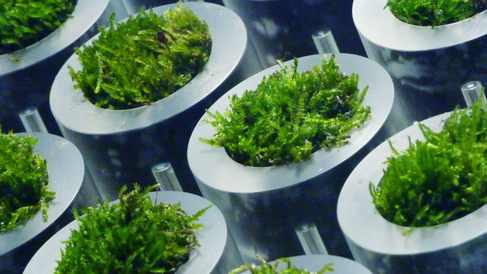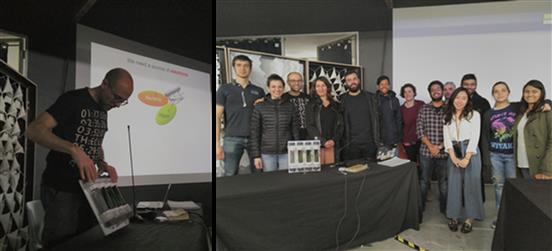Academic Partners

2019-02-22 (Friday) - University of Southampton (Southampton, UK)
Meeting attendees
- Antony Lindley
- Dr. Peter Glynne-Jones
- Dr Paolo Bombelli
- Several colleagues and students
I first delivered a departmental seminar, then Mr. Lindley and Dr. Clynne-Jones have shown me their first prototype of microfluidic imaging system for the analysis of algae and other phytoplankton using a novel ultrasonic technology. I look forward to see more of this technology in the near future.
2019-03-01 (Friday) - IAAC
(Barcelona, Spain)
Meeting attendees
- Dr Chiara Farina (IAAC)
- Mohamad Elatad (IAAC)
- Guillem Camprodon (IAAC)
- Dr Paolo Bombelli
First, the BPV/BES technology has been presented to the students of the IAAC.

Then, we have discussed about integrating the BPV/BES technology with the Smart Citizen Kit. The Smart Citizen is a platform which was founded by Tomas Diez (IAAC, Fab Lab Barcelona) and Alex Posada (MID, Hangar) for having citizens as part of social experiment in urban areas. The objective of the Smart Citizen platform is to serve as a node for building productive and open indicators and distributed tools. The project is in a constant expansion with more than 1000 kits around the world.
During my meeting we have discussed about the possibility to have a BPV system for powering a Smart City Kit. Further discussion is ongoing to define the minimum power requirement for running a simple Smart City Kit with limited data transferring.
https://iaac.net/project/smart-citizen/
2019-03-05 (Tuesday) - MCI, the Entrepreneurial School
(Innsbruck, Austria)
Meeting attendees
- Prof. Christoph Griesbeck (MCI)
- Dr Paolo Bombelli
In this bilateral meeting I have discussed with Prof Griesbeck the potential of BPV/BES systems (e.g., generation of electrical energy, tool to instigate the cellular metabolism and tool to change to cellular metabolism). In exchange, Prof Griesbeck has shared with me his interests for the production of high value products (for pharmaceutical and cosmetic uses) based on algae platforms. He also has access to a rare collection of alpine algae which could have a great bio-technological potentials.

2019-03-06 (Wednesday) - University of Padova
(Padova, Italy)
Meeting attendees
- Prof. Marcella Bonchio (University of Padova)
- Prof Tomas Morosinotto (University of Padova)
- Dr Paolo Bombelli
With Prof Bonchio we have discussed the characteristics of inorganic systems for water splitting (polyoxo metallate with ruthenium – Ru-POM) and associated antenna. Our discussion was focused on the possibility to associate the Ru-POM with biological components. With Prof Morosinotto we have discussed the possibility to test some of his algal strains into the bio electrochemical system, especially those able to form a strong biofilm due the extracellular matrix.

2019-03-15 (Friday) - University of Bari
(Bari, Italy)
Meeting attendees
- Dr Massimo Trotta (University of Bari)
- Dr Francesco Milano (University of Bari)
- Prof Gianuca Farinola (University of Bari)
- Prof Cosma Pinalysa (University of Bari)
- Dr Paolo Bombelli
Dr. Trotta and Dr Milano both collaborate on projects for developing bioelectrochemical systems using photosynthetic non-oxygenic bacteria. Our discussing was based on possible collaboration for combining the oxygenic and non-oxygenic organisms in a novel BES device.
https://users.ba.cnr.it//ipcf/csilmt12/
https://users.ba.cnr.it//ipcf/csilfm22/
Prof Cosma leads a project of for wastewater treatment named Life Clean Up in conjuction with several European partners In this project the cyclodestrins are used as encapsulation agents for dyes coming from textile processes. More details in the following link: https://www.lifecleanup.eu/project-life
Prof Farinola and his group develop new multifunctional molecular, polymeric and supramolecular photo/electro active architectures for applications ranging from organic photonics and electronics to biology. Based on that, we have discussed the idea to dope the silica shell structure of diatoms with electric conductive elements to be used as an anodic electrode for BES application.
http://www.chimica.uniba.it/it/dipartimento/personale/professori-ordinari/215-farinola-gianluca


2019-03-19 (Tuesday) - University of Tirana (Tirana, Albania)
Meeting attendees
- Prof Aleko Miho
- Dr Paolo Bombelli
- Several colleagues and students
I first delivered a departmental seminar at the Department of Biology, explaining the theory on which photosynthetic-BESs operate. Then, I delivered a practical demonstration for performing on the BEST device a polarisation by using external resistors and a digital voltmeter. Finally, with Prof Miho and two master students we took samples from the four units of the BEST device (CH1n.c., CH2, CH3 and CH4) to check under an optical microscope the cellular composition of the cell suspension.

(20/21-03-2019) Field trip led by Prof Miho to the Lezha wetland (South and North) for sempling micro and macro algae, water and sediments for environmental monitoring.

2019-04-05 (Friday) - Norwegian University of Science and Technology NTNU (Trondheim, Norway)
Meeting attendees
- Erland Årstøl
- Ivana Jevremovic
- Paolo Bombelli
- Several colleagues and students
I first delivered a departmental seminar at the Department of Chemistry (Norwegian University of Science and Technology, NTNU), explaining the theory on which photosynthetic-BESs operate.
Then, with Ivana Jevremovic and Erland Årstøl we have discussed common interest with the aim to define plan for possible future joint project. Our discussion was based on the following points.
- Study the interface of cells (e.g.,cyanobacteria) with electric conductive surfaces. This from both the biological and physical material point of view.
- Define a common protocol for creating a cellular biofilm on electrode.
- Analyse samples of the anodic material in use in the BEST device (colonised anode in BG11 media, anode in BG11 madia only and brand new anode).
Many thanks to Prof Martin F. Hohmann-Marriott and Erland Årstøl for facilitating my visit in Trondheim.

2019-04-12 (Friday) - Technical University of Denmark DTU
(Copenhagen, Denmark)
Meeting attendees
- Stephan Keller
- Paolo Bombelli
- Several colleagues and students
I first delivered a seminar at the group of Dr Keller where the theory on which photosynthetic-BESs operate was discussed. Then, with Stephan Keller and Galina we have discussed common interests with the aim to define plan for possible future joint project. Our discussion was based on the following points.
- Preliminary experiment to start. Testing the biofilm formation on several electric conductive material. Candidate electric conductive materials include: carbon, ITO, aluminium(with Al2O3). Spectroscopic technique and microscopy (fluorescence microscope) can be used to analyse the formation of biofilm.
- Create a simple, solid and modular BES platform for rapid and systematic cells screening.
Many thanks to Dr Keller for facilitating my visit at the DTU in Copenhagen.

2019-04-17 (Wednesday) – University of Iceland
(Reykjavik, Iceland)
Meeting attendees
- Sigurður Brynjolfsson
- Paolo Bombelli
- Egill Skúlason
- Several colleagues and students
I first delivered a departmental seminar at the Center for Systems Biology and Chemical Engineering where i) I introduced the theory on which photosynthetic-BESs operate and then ii) I discussed possible real world applications for this technology.
With Sigurður Brynjolfsson and Egill Skúlason we have discussed common interests with the aim to define plan for possible future joint project. Our discussion was based on the following points.
- Microbial (and electro-microbial) methods for treating the exhausted vapor coming out from the geothermal power plant.
- Mathematical model to study some of the steps of electron transport at the cell to electrode interface.
Many thanks to Prof Brynjolfsson for facilitating my visit at the University of Iceland.

2019-04-26 (Friday) SAMS and CCAP
(Oban, UK)
Meeting attendees
- Michael Ross
- David Green
- Paolo Bombelli
- Several colleagues and students
Departmental seminar at the SAMS and CCAP in Oban. Many thanks to Dr Ross for facilitating my visit.
With Dr Green we have discuss the possibility to analyse the communities associated with the anodes at the SAMS.

2019-04-30 (Tuesday) University of Bath, Department of Chemistry
(Bath, UK)
Meeting attendees
- Adam Squire
- Petra Cameron
- Frank Marken
- Mirella Di Lorenzo
- Paolo Bombelli
- Several colleagues and students
Departmental seminar at the Department of Chemistry. Many thanks to Dr Squire for facilitating my visit.
With Prof Marken, Dr Squire, Dr Cameron and Dr Di Lorenzo we have discuss the possibility to develop novel bio compatible electrochemical surface for the development of bio-electrochemical systems.

2019-05-07 (Tuesday) University of Milano, Department of Environmental Science and Policy (ESP)
(Milano, Italy)
Meeting attendees
- Dr Andrea Schievano
- Prof Stefano Bocchi
- Dr Lucia Cavalca
- Dr Sarah Zacchin
- Prof Luisella Verotta
- Paolo Bombelli
- Several colleagues and students
Many thanks to Dr Schievano, Prof Bocchi and Prof Trassati for facilitating my visit.
With Dr Schievano, Dr Cavalca and Dr Zecchin we have discuss the possibility to combine the photo anodic element of the BEST device with the cathodic components developed in Milan for N2 fixation.

2019-05-09 (Thursday) MANAGEMENT CENTER INNSBRUCK
(Innsbruck, Austria)
Meeting attendees
- Prof. Christoph Griesbeck (MCI)
- Dr Paolo Bombelli
- The undergraduate students of the MCI
Many thanks to Prof Griesbeck for inviting and facilitating my visit.

